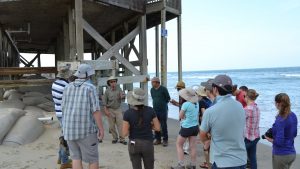From the shifting sands of the Outer Banks in the east to the high mountain soils of the west, undergraduates from across the United States got an up-close look this summer at North Carolina’s variety of soils and landscapes.

NC State University’s Soil Geomorphology Tour was part of a National Science Foundation-sponsored program called an REU, or research experience for undergraduates. It is currently the only soils-related REU in the country.
NC State received a three-year grant from NSF to offer the Basic and Environment Soil Science Training program. NC State University graduate students also joined the trip, as did visiting undergraduate and graduate students from Brazil and a visiting scientist from China.
The tour’s goal is to help the participants understand the importance of soils in their lives, said tour leaders Mike Vepraskas and Josh Heitman. Vepraskas and Heitman are faculty members in NC State’s Department of Crop and Soil Sciences.
As the students traveled the state, they learned to describe and classify different types of soils and gained a better understanding of how and why soils formed in different places.

They also encountered first hand some of the unique hazards that soils can pose: On the coast, they saw the threat that coastal soil erosion poses to houses that are built too close to the sea. Inland, they encountered waterlogged organic soils that have to be drained if they are to be used for agriculture. And in the Piedmont’s Triassic Basin, they learned that soils contain a clay mineral that swells when wet then shrinks when it dries, frequently cracking building foundations.
“Students need to know about soils to understand how land can be managed in sustainable ways that pose little harm to the environment,” Vepraskas said. “The week spent in the field is a unique, hands-on experience that teaches technical skills and provides broad exposure to the challenges and benefits soils create.”